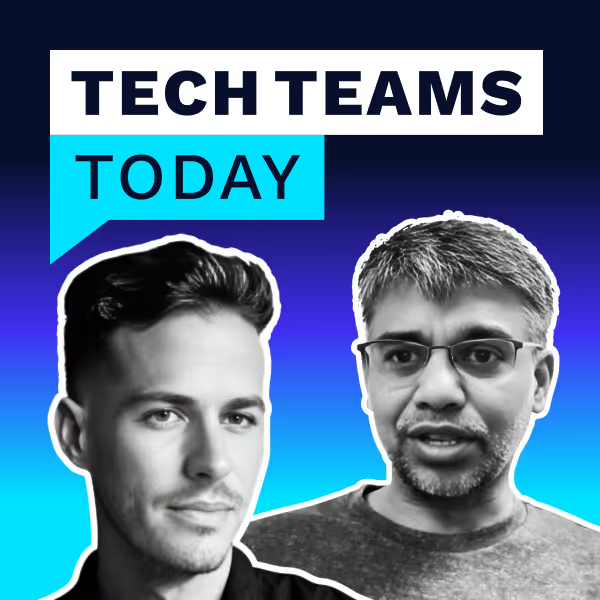In today’s rapidly shifting tech environment, engineering leaders are navigating more variables than ever: evolving customer expectations, new architectural paradigms, and AI that’s rewriting the rules of software delivery.
In this episode of Tech Teams Today, I sat down with Prabhu Inbarajan, Chief Product and Technology Officer at Colibri Group, who has spent more than two decades leading global teams at Blackhawk Network, Intuit, and eBay. Unusually, Prabhu owns both product and engineering, giving him a rare vantage point on how to align strategy and execution.
We covered everything from AI-native vs AI-adaptive product decisions, to scaling teams across continents, to why simplicity—not complexity—is the ultimate marker of engineering excellence.
If you’re building a new product or taking over an existing one, these insights will make you think differently about where to place your bets.
Simplicity Is the Hardest Thing to Build
Prabhu’s career has reinforced a core truth: the hardest systems to build are the simplest ones. Simplicity is rarely about doing less—it’s about doing the right things in the right way, and removing anything that doesn’t directly serve the customer.
He draws parallels to products like the iPhone, which hide deep technical complexity behind effortless design. The teams that pull this off aren’t taking shortcuts—they’re making thousands of deliberate choices to strip away unnecessary friction.
“What is the most simple thing we can do that actually solves the problem?” is the question Prabhu comes back to again and again.
Key Takeaway: Simplicity isn’t laziness, it’s mastery. The best leaders push their teams to deliver solutions that are clear, elegant, and easy for the customer, even when the engineering effort behind them is enormous.
AI-Native vs AI-Adaptive: Choosing Your Path
As AI reshapes software, leaders face a decision similar to picking a framework or refactoring a codebase: Do you go AI-native from day one, or layer AI in as you go?
Prabhu warns against chasing the label. AI-native can be powerful, but it’s also expensive, risky, and hard to execute at production scale, especially if you haven’t validated your product-market fit. AI-adaptive approaches let you integrate capabilities into existing systems, test real-world impact, and scale the best results.
At Colibri, they approach this through capability building blocks—modular AI components that lower integration costs and can evolve from adaptive to native over time.
Key Takeaway: Don’t rebuild for AI without earning the right to win. Use adaptive approaches to prove value quickly, then scale what works into native architectures.
Trust Is the Real Driver of AI Adoption
For all the talk about model accuracy, Prabhu believes the real shift in generative AI is about trust. Ten years ago, machine learning adoption was slow because people hesitated to hand over decisions to unsupervised systems.
Now, users are more willing to accept “good enough” results if they can review, refine, and apply them. This trust accelerates adoption, creates more usage data, and drives rapid model improvement in what Prabhu calls a self-reinforcing loop.
Key Takeaway: Accuracy matters, but trust drives adoption. Build systems your users feel confident building on top of, not just consuming blindly.
AI as Infrastructure and Product
Prabhu views AI as more than just a product feature, it’s a foundational part of the company’s infrastructure. At Colibri, AI is embedded in internal workflows (like meetings, note-taking, and decision-making) as well as customer-facing experiences.
He’s especially excited about agentic orchestration shifting from thinking in terms of microservices to thinking in terms of reusable AI agents that can be orchestrated for different outcomes.
Key Takeaway: Treat AI as both infrastructure and product. Use it to improve how your teams work and how your customers experience your solutions.
Aligning Product Vision with Technical Architecture
Too often, technology is treated as an implementation detail after product decisions are made. Prabhu rejects that model. In his “two in a box” approach, product and technology leaders are equal partners in discovery, design, and delivery.
This ensures architectural decisions are rooted in real customer problems and that trade-offs are evaluated together—not thrown over the fence.
Key Takeaway: Architecture is strategy. Align product vision and technical execution from day one to avoid costly misalignment later.
Scaling Global Teams Through Trust
During the pandemic, Prabhu grew the team at Blackhawk Network to over 200 people. Prabhu attributes the success to trusting top talent, aligning everyone to the mission, and letting teams own the how while leadership focused on the what and why.
Micromanagement may optimize for short-term local wins, but trust enables consistent delivery at a global scale.
Key Takeaway: Trust isn’t a soft skill—it’s a scaling strategy. Empower teams to make decisions, and they’ll find the most efficient paths to results.
Smaller Teams, Bigger Outcomes
Looking ahead, Prabhu sees AI-enabled teams accomplishing 10x more with fewer people. This shift will change hiring, team composition, and leadership priorities. Leaders will need to focus on leverage—removing blockers, providing tools, and enabling speed without sacrificing quality.
Key Takeaway: The future belongs to lean, empowered teams. Invest in tools and culture that maximize their impact.
Closing Thoughts
Prabhu’s perspective is a reminder that leadership in 2025 isn’t about chasing the latest tech—it’s about making intentional decisions on architecture, process, and culture that will stand the test of time. Whether you’re building AI-native products from scratch or layering AI into a proven system, the challenge is the same: earn the right to scale, keep it simple, and trust your teams.
📺 Watch the full episode on YouTube






